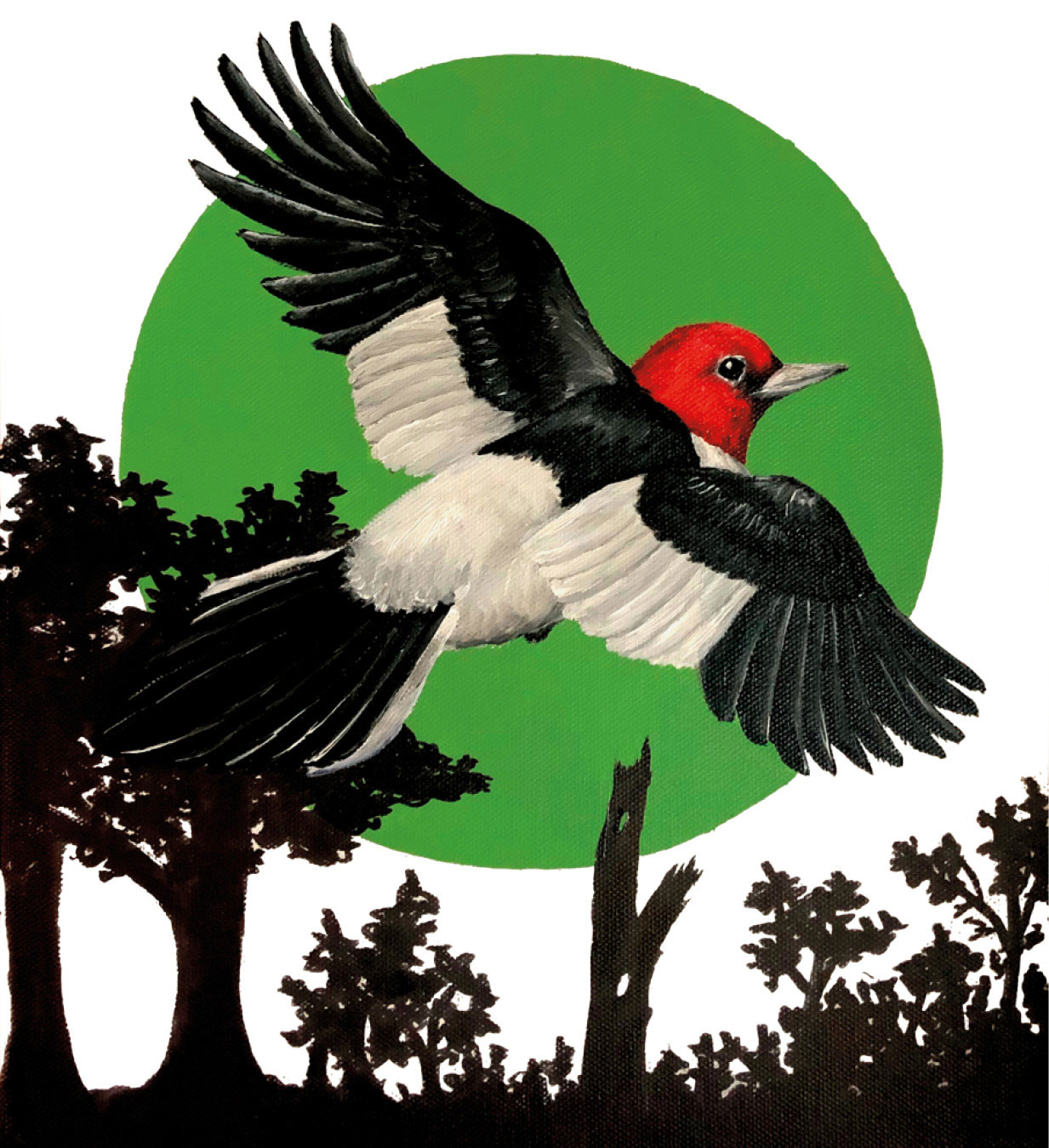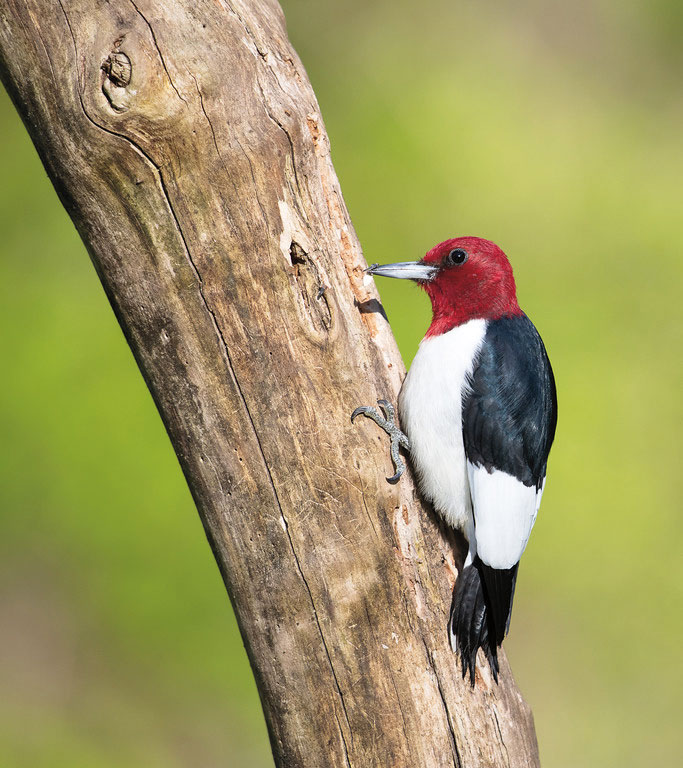The Birders’ Dozen
Profile 1: Red-headed Woodpecker
Welcome to the Birders’ Dozen! Over the next several issues, we are going to introduce a series of bird species from Forestry for the Birds. The Birders’ Dozen are forest birds that can benefit from targeted management practices, as most are declining due to habitat loss. We’ve curated this list to cover a wide range of habitat types, from young to mature forest, open to closed canopy, or dense to non-existent shrub layers. Our goal is to engage landowners and foresters in the process of managing forests for wildlife, or “forests for the birds.”
 In this first profile, we’ll meet one of the poster children for the project, the Red-headed Woodpecker.
In this first profile, we’ll meet one of the poster children for the project, the Red-headed Woodpecker.
Our most boldly patterned woodpecker, this charismatic bird can be heard giving its loud call, almost like a bark, from snags (standing dead trees) and large trees in open woodlands and savannas (a transitional habitat type between grassland and woodland). They’re the only woodpecker in the Central Hardwoods that are sexually monomorphic, which means males and females both share the distinctive red head that gave the species its name.
Though its population has cycled over the last few centuries, it has decreased significantly in recent years. Reforestation in the eastern part of the continent has benefitted many species, but the Red-headed Woodpecker depends on openings and edge habitats, as well as dead trees for foraging and nesting.
Natural History
Red-headed Woodpeckers are regularly present in oak savannas and woodland areas, as well as forested areas opened by disturbances. In the breeding season, these omnivorous woodpeckers eat primarily seeds and nuts, though insects and small vertebrate prey such as mice and nestling birds are occasionally taken as well. In fact, Red-headed Woodpeckers are one of the few woodpeckers that can catch flying insects in addition to wood-boring insects. Their boldly patterned feathers can be seen flashing as they sally out from conspicuous perches, catching insects in their bright white bill. In the non-breeding season, hard mast such as acorns, beechnuts, and pecans are their primary food. In order to find this food source, Red-headed Woodpeckers move into mature forests during the winter, and can often be found in habitats traditionally associated with mature forest specialists such as Wood Thrushes and Cerulean Warblers.
Most foraging occurs on dead limbs and trunks, as does nesting. Red-headed Woodpeckers are primary cavity nesters, which means they excavate their own nest holes in dead trees or dead portions of live trees; these holes are occasionally re-used by the same breeding pair and often used by a variety of species in subsequent years (Frei et al. 2020). In fact, one of our other target species, the Eastern Screech-Owl, can later use cavities originally created by Red-headed Woodpeckers.
Male and female Red-headed Woodpeckers, which can remain together for several years, create a cavity that’s approximately 12 inches deep and 3-6 inches wide, into which the female lays a clutch of 3-10 small, white eggs. A second brood is possible, and the parents often raise this subsequent brood in a second snag. After a two-week incubation period and a month-long nestling period, fledglings leave the nest and begin foraging for themselves. These fledglings have a gray head, rather than the distinctive red of the adults, but quickly molt and grow bright red feathers.
Habitat Management
Retention of snags and creation of clearings, as well as encouraging growth of oak and other mast crop species like beech and pecan, can greatly benefit the Red-headed Woodpecker. In many parts of the continent, prescribed fire can create this woodpecker habitat, fostering a savanna habitat type. Beaver-caused damming of streams can also create a flooded forest habitat type with plenty of snags. Even in small habitat patches, creation of a single snag by girdling a tree can be beneficial.
The Red-headed Woodpecker is a unique species on our list, in that it is migratory but its summer and winter ranges overlap in Indiana and the Central Hardwoods. Birds you see in the summer in your patch of young forest or savanna will spend the winter in mature forests in the southern part of the United States, while the birds in your stand of oaks and beeches in the winter came from young forests in the northern states. In essence, this means that forest management for both young and mature forests can benefit this species across its entire range, and can benefit other birds in both habitat types. In particular, management for early successional forest such as the habitat types used by breeding Red-headed Woodpeckers can mitigate habitat loss that has affected this and many other species.
If large scale forest management is unfeasible in your habitat patch, backyard management can also benefit Red-headed Woodpeckers and other wildlife species. These woodpeckers occasionally come to bird feeders, so provision of clean water and regularly-cleaned feeders with protein-rich food can be beneficial. However, window collisions, especially at rural houses with feeders, can be a risk for woodpeckers and many other bird species. Turn off excess lights at night, cover windows with reflective materials, and place feeders at least 25 feet away from windows. In addition, pesticides such as neonicotinoid insecticides such as Imidacloprid can damage insect populations on which woodpeckers depend, and lessening or stopping their use can have benefits for woodpecker abundances.
Conclusion
Though the Red-headed Woodpecker’s population is dropping due to habitat loss, woodland owners in Indiana have a unique opportunity to foster this charismatic species. Breeding woodpeckers can greatly benefit from creation and maintenance of early successional forest, and wintering woodpeckers from maintenance of mature forest, particularly when snag retention is part of the management plan. We hope that land owners and foresters can benefit from Forestry for the Birds, for the benefit of both overall forest health and Red-headed Woodpeckers.
Special thanks to the Alcoa Foundation, the Indiana Forestry Educational Foundation, and The Nature Conservancy for their support and leadership of Forestry for the Birds.
References
Environment and Climate Change Canada. 2019. Recovery Strategy for the Red-headed Woodpecker (Melanerpes erythrocephalus) in Canada [Proposed]. Species at Risk Act Recovery Strategy Series. Environment and Climate Change Canada, Ottawa. viii + 118 pp.
Frei, Barbara, et al. “Red-Headed Woodpecker (Melanerpes Erythrocephalus).” Birds of the World. https://birdsoftheworld.org/bow/species/rehwoo/cur/introduction. Accessed 4 March 2020.
Pyle, Peter, and Steve NG Howell. “Flight-Feather Molt Patterns and Age in North American Woodpeckers.” Journal of Field Ornithology, JSTOR, 1995, pp. 564–581.
Red-Headed Woodpecker Overview, All About Birds, Cornell Lab of Ornithology. https://www.allaboutbirds.org/guide/Red-headed_Woodpecker/overview. Accessed 17 June 2021.
Jessica Outcalt is an independent consultant working with The Nature Conservancy since 2020. Her “day job” is as a field technician doing avian surveys with WEST, an environmental consulting firm. She completed her BS in biology at Taylor University, her PhD in wildlife ecology at Purdue University, and is passionate about birds and getting people involved in conservation and scientific processes.
PHOTO CREDIT: Photo by Matt Williams Nature Photography
